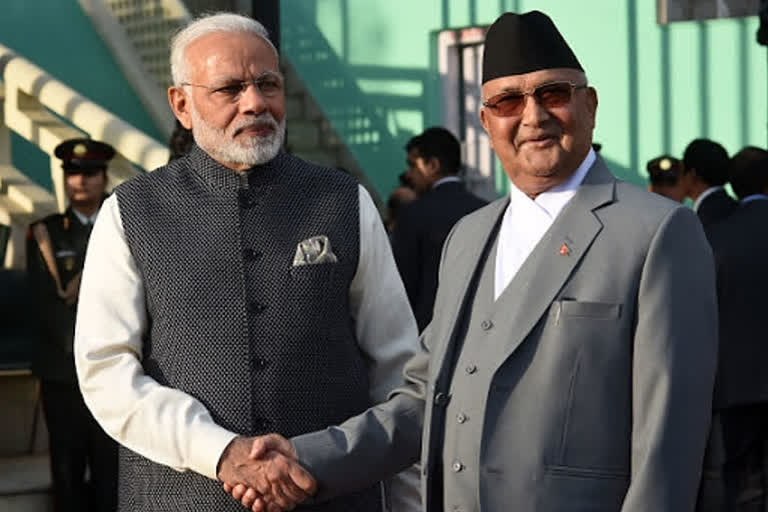Hyderabad: India’s closest neighbour and ally, Nepal, was least expected to revisit old colonial agreements and stake claim on a disputed piece of land with its closest neighbour and ally. It hastily enacted a bill in the parliament and incorporated three places, Kalapani, Lipulekh and Limpiyadhura into Nepal.
An incensed New Delhi was in dithers about how to react to this brazen act- with anger, disdain or with indifference. It’s conundrum aggravated with its border-related pro-occupation with China that had not just moved its troops closer to the Line of Actual Control (LAC), but was testing India’s resolve to protect its unmarked borders.
What has happened on June 15 and the manner in which India agreed to the Chinese assertion about LAC and what it controls will have implications on how Nepal challenges India on the land border issue.
Why did Nepal buttress its claims on a disputed territory at this juncture? Was it choreographed by Prime Minister KP Sharma Oli to deflect from his troubles or was it encouraged by China, which is aggressively nibbling away India’s influence in the region?
While the timing of Nepal’s attempts to eat into disputed areas may seem to be linked to that of China, but there are plenty of reasons to suggests that Oli’s decision was prompted more by his frosty ties with New Delhi than anything else. Indian Chief of Army Staff, General Naravane, had misread what was happening in Kathmandu and in Oli’s mind when he blamed China for Nepal’s belligerence. Though there was some backtracking, this suggests that a sovereign ally was incapable of taking an independent decision created an uproar in Kathmandu’s ruling circles.
READ: Amidst complex border dispute, Nepal changes citizenship law for Indians
Thereafter, the Nepalese government fast-tracked its formal acquisition of these three places that have been claimed by India. The Nepalese did not pause to check with New Delhi what it thought about their decision or would it be open to negotiations. It was only after the bill had been enacted that the Oli government decided to reach out to New Delhi saying that it was ready to talk with India. "What’s there to talk now", remarked a former India’s Ambassador to Nepal. Plenty, if the Indian government decides to introspect about why there is so much antipathy towards New Delhi and why symbolic acts like taking control of disputed areas were lending swagger amongst Nepalese.
Oli’s quality of governance has come under severe criticism. There has been agitation by the young about how shoddily Oli has handled the global pandemic. The numbers have been soaring. Here, too, Oli shifted the blame towards India alleging that the most virulent cases were coming from across the border. The truth is that very few people returned from India.
Oli has been upset with New Delhi as he allegedly believes that it was behind attempts to throw him out when he fell ill. Even Prachanda’s opposition to him was allegedly traced to India’s encouragement. Oli survived after the intervention by the Chinese ambassador in Nepal, who is socially far more accessible.
Oli latched on the opportunity provided by the thoughtlessly conceived inauguration by Defense Minister Rajnath Singh of the road to Kailash Mansarovar through Lipulekh pass, which Nepal claimed it as its territory. Nepalese foreign minister Pradeep Gyawali said: “The link road inaugurated by India has been built in the territory that historically belongs to Nepal. As per the Sugauli Treaty of 1816, the territory to the east of the Mahakali river belongs to Nepal and both sides had agreed way back in 1988 to follow the principle of ‘fixed border’ in determining the border of Nepal,” Nepal had protested when Prime Minister Narendra Modi visited China and decided to build border post at Lipulekh to help the pilgrims for the long pilgrimage. What also rankled the Nepalese was the obvious attempts of the Indian leadership to use the Mansarovar yatra to mobilise the Hindus in a country where it is in a majority.
Also, read: Pragmatism key for India to sort out border row with Nepal, say experts
Indian government under Modi has tried to enlarge the country’s influence by trying to use the Hindu civilizational links. These moves have backfired. Nepal perceives Hinduism with the feudalism represented by the Rana dynasty, with which the Maoists had a bitter fight. Relationship between India and Nepal got bitter when the leadership in Kathmandu refused to declare Nepal as a Hindu state.
Ever since 2015, India’s relationship with Nepal has been on a downslide and Indian government despite the special relationship has not been able to reimagine these ties. What causes more problems for future ties with this landlocked country is New Delhi’s tendency to view it from the prism of China.
This attitude hurts India, Nepalese and the close ties at different levels. What is worrying is as Indian economy performs badly, it would no longer be an attractive destination for many young Nepalese looking for a job.



